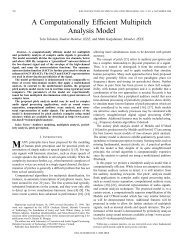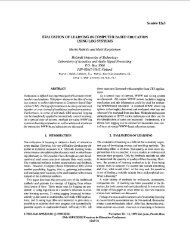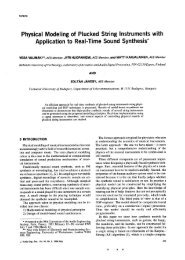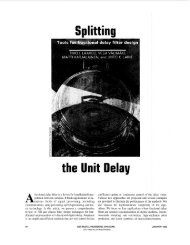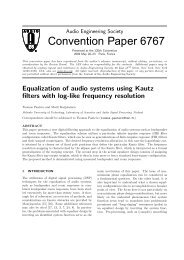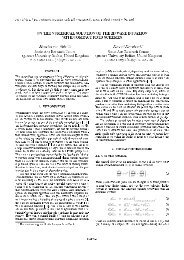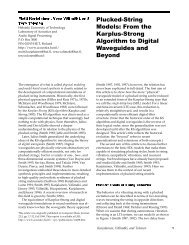DSP Formulation of a Finite Difference Method for Room Acoustics ...
DSP Formulation of a Finite Difference Method for Room Acoustics ...
DSP Formulation of a Finite Difference Method for Room Acoustics ...
Create successful ePaper yourself
Turn your PDF publications into a flip-book with our unique Google optimized e-Paper software.
600AxialGroup delays (in samples)40020000 0.05 0.1 0.15 0.2 0.256004002002−D Diagonal00 0.05 0.1 0.15 0.2 0.256004002003−D Diagonal00 0.05 0.1 0.15 0.2 0.25Normalized frequency (Nyquist == 0.5)Fig 6. Group delays in three different directions, axial,2D diagonal and 3D diagonal.( 1 + r) ⋅ z – 1 poppp = -----------------------------------------(11)1 + rz – 2This result is found by using equation (4) and setting+p wall= 0 , since there is no input from inside the wall.In addition the following relation between impedanceZchange and reflection factor is used: r 2 – Z= ------------------ 1. Equation(11) can also be expressed as a difference equationZ 2 + Z 1pn ( ) = ( 1 + r) ⋅ p opp( n – 1)– r ⋅ p( n–2)(12)where p is the boundary node and p opp is its neighbor. Ingeneral the boundary condition can be replaced by anydigital filter.Figure 7 shows behaviour <strong>of</strong> some simple boundaryconditions. The model consists <strong>of</strong> three rooms constructed<strong>of</strong> different materials. The first figure shows the roomconfiguration, excitation shape and first order phase preservingreflection from the ceiling. In the second one thereare phase reversing reflections from the walls. The wallsseparating rooms are anechoic.5. SUMMARY AND FUTURE WORKIn this paper we have shown that finite difference time domainmethod can also be <strong>for</strong>mulated in terms <strong>of</strong> digitalsignal processing. The study is based on digitalwaveguides.In the future we are going to make this algorithm tobetter suit real room acoustic problems. This includes adetailed study on boundary conditions and also on coupling<strong>of</strong> different sound propagation mediums. To enhancedispersion characteristics various interpolationtechniques are under study, and some results are describedin a companion paper [9].Fig 7. Visualization <strong>of</strong> simulation, excitation andfirst order reflection (above), wall reflections (below).REFERENCES[1] D. Botteldooren, “<strong>Finite</strong>-difference time domain simulation<strong>of</strong> low-frequency room acoustic problems,” J.Acoust. Soc. Am., vol. 98, no. 6, pp. 3392-3308, 1995.[2] J. Smith, “Physical modeling using digitalwaveguides,” Computer Music Journal, vol. 16, no.4, pp. 75-87, Winter 1992.[3] S. Van Duyne and J. Smith, “Physical modeling withthe 2-D digital waveguide mesh,” In Proc. 1993 Int.Computer Music Conf., Tokyo, Sept. 10-15, 1993, pp.40-47.[4] L. Savioja, J. Backman, A. Järvinen, and T. Takala,“Waveguide mesh method <strong>for</strong> low-frequency simulation<strong>of</strong> room acoustics,” In Proc. 15th Int. Congresson <strong>Acoustics</strong> (ICA’95), Trondheim, Norway, June 26-30, 1995, vol. 2, pp. 637-640.[5] L. Savioja, A. Järvinen, K. Melkas, and K. Saarinen,“Determination <strong>of</strong> the low-frequency behaviour <strong>of</strong> anIEC listening room,” In Proc. Nordic AcousticalMeeting (NAM’96), Helsinki, Finland, June 12-14,1996, pp 55-58.[6] H. Samet, The Design and Analysis <strong>of</strong> Spatial DataStructures, Addison-Wesley, 1990.[7] S. Van Duyne and J. Smith, “The tetrahedral digitalwaveguide mesh”, In Proc. 1995 IEEE ASSP Workshopon Applications <strong>of</strong> Signal Proc. to Audio and<strong>Acoustics</strong>, New Paltz, NY, Oct. 1995.[8] S. Van Duyne and J. Smith, “The 3D tetrahedral digitalwaveguide mesh with musical applications”, InProc. 1996 Int. Computer Music Conf., Hong Kong,Aug. 19-24, 1996, pp. 9-16.[9] L. Savioja and V. Välimäki, “The bilinearly deinterpolatedwaveguide mesh,” In Proc. NORSIG’96 IEEENordic Signal Processing Symposium, Espoo, Finland,Sept. 24-27, 1996.






